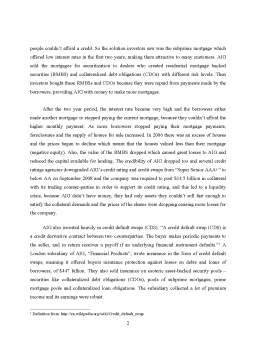Extras din referat
Introduction
In this project we are going to present the implication of AIG in the financial crisis, how their greed led them from mistake to mistake, underestimating the high risks of the market due to their 90 years experience in insurance and to the size of the company taking into consideration that they have subsidiaries in over 130 countries. Because AIG is so interconnected with the entire world, the U.S. Government had to step in and come up with a plan to restore the economic stability, so that the global economy will not fall. Furthermore, we will talk about the bonuses AIG paid to its executives from the public money they received as a bail-out and how the Government reacted to this absurd decision. In addition, we will present some of the plans AIG is considering to apply in order to recover and to calm the American taxpayer.
1. What went wrong?
American International Group, Inc. (AIG) is a major American insurance corporation with operations in more than 130 countries. AIG is so interconnected with other banks and financial firms all over the world that its problems will affect them as well. This is the main reason why the U.S. Government won’t let this company fall into bankruptcy. But how could such a prestigious company be on the verge of bankruptcy?
It all started about a decade ago when AIG, and other banks as well, began offering subprime mortgages. There is no exact definition to sub-prime mortgages, but these are usually money granted to high risk borrowers (also called subprime borrowers). According to the U.S. Department of Treasury guidelines issued in 2001, "Subprime borrowers typically have weakened credit histories that include payment delinquencies and possibly more severe problems such as charge-offs, judgments, and bankruptcies. They may also display reduced repayment capacity as measured by credit scores, debt-to-income ratios, or other criteria that may encompass borrowers with incomplete credit histories."
But why would they take such a high risk? The answer is simple: at the time there was an overwhelming demand for houses, which meant that the price was constantly increasing, but people couldn’t afford a credit. So the solution investors saw was the subprime mortgage which offered low interest rates in the first two years, making them attractive to many customers. AIG sold the mortgages for securitization to dealers who created residential mortgage backed securities (RMBS) and collateralized debt obligations (CDOs) with different risk levels. Then investors bought these RMBSs and CDOs because they were repaid from payments made by the borrowers, providing AIG with money to make more mortgages.
After the two year period, the interest rate became very high and the borrowers either made another mortgage or stopped paying the current mortgage, because they couldn’t afford the higher monthly payment. As more borrowers stopped paying their mortgage payments, foreclosures and the supply of homes for sale increased. In 2006 there was an excess of houses and the prices began to decline which meant that the houses valued less than their mortgage (negative equity). Also, the value of the RMBS dropped which caused great losses to AIG and reduced the capital available for lending. The credibility of AIG dropped too and several credit ratings agencies downgraded AIG’s credit rating and credit swaps from “Super Senior AAA+” to below AA on September 2008 and the company was required to post $14.5 billion in collateral with its trading counter-parties in order to support its credit rating, and this led to a liquidity crisis, because AIG didn’t have money, they had only assets they couldn’t sell fast enough to satisfy the collateral demands and the prices of the shares were dropping causing more losses for the company.
AIG also invested heavily in credit default swaps (CDS). “A credit default swap (CDS) is a credit derivative contract between two counterparties. The buyer makes periodic payments to the seller, and in return receives a payoff if an underlying financial instrument defaults.” A London subsidiary of AIG, “Financial Products”, wrote insurance in the form of credit default swaps, meaning it offered buyers insurance protection against losses on debts and loans of borrowers, of $447 billion. They also sold insurance on esoteric asset-backed security pools – securities like collateralized debt obligations (CDOs), pools of subprime mortgages, prime mortgage pools and collateralized loan obligations. The subsidiary collected a lot of premium income and its earnings were robust.
Preview document
Conținut arhivă zip
- AIG - World's Biggest Domino Piece.doc













